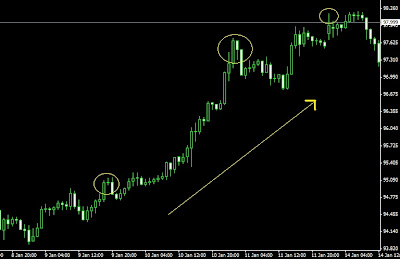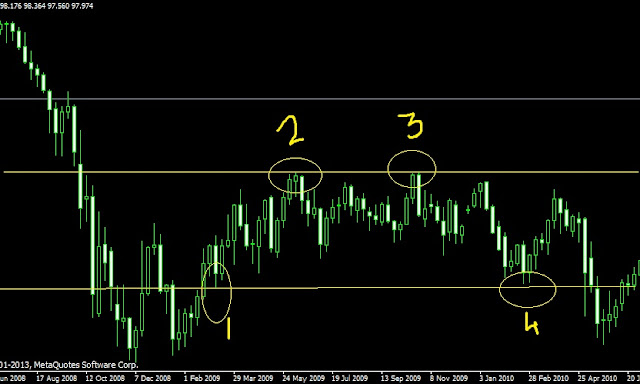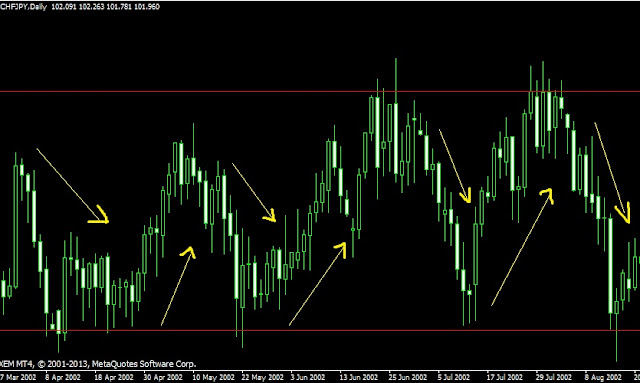Trend is the direction in which price moves. Identifying the trend of currency pair is the most important part of any forex trading strategy.Once you have a clear idea about where the price is heading taking a trade will be much more easier. That means if the price is going up then a buy trade will give you profit and vice-versa. So let's look at the different trends.
Price will move mainly in 3 directions.
- Up
- Down
- Range
When the price is moving up it is called an uptrend.
See the above chart. The price on 8th January was around 93.83, but as on 14th January it is around 97.99. Price has moved up. This is a typical example of up trend.
Identification:
Up trend can be identified with the formation of higher highs and higher lows:
See the encircled portion of the above chart on 9th january. That is a peak. The encircled portion on 11th january is the next peak produced which is above the last peak.that means the price is producing higher high's. See the third encircled peak that is above both previous peaks.
DOWN TREND:
When price moves down it is called a down trend.
The above chart shows a down trend. Price is moving down.
Identification:
Down trend can be easily identified by the lower lows or lower high's produced:
In the above chart the encircled portion shows the the lower low's produced. Each low created by the chart is below the previous low.
RANGING:
One other major direction in which price moves is by ranging. In this condition the price will not move up or down but sideways.
Above chart shows ranging of price.
In this the first encircled portion shows that the price has changed it's down trend and started going up. But the price has gone up only to point indicated by the second circle. After that the price reverses due to a strong resistance and again goes down, but easily finds a support at a small distance. This up and down movement of price continues until price manages to break the support and resistance levels. During the entire period from February 2009 to April 2010 price was moving in between the 2 yellow lines drawn. So all that period price was not able to go beyond 2nd circle and not less than 4th circle. This is ranging.
A range will contain small up and down trend
The above chart shows the price ranges between the 2 red lines. See the arrows the first left arrow shows the price moving down and at the resistance it bounces back and moves up. This pattern is repeated till the price breaks the range. So a trader can take advantage of this movement and can place buy trades at the point of upward journey and place short trades during down ward journey.
Length of trend:
A trend can be of hours to years i.e. Some trend may change the direction within hours but some trend will take years. There are
- Short term trends--trend duration for a very short period of time
- Long term trends---trend duration for a very long period of time.
How to identify trend
The basic way of identifying the trend is to look from left to right of your screen, if the price is moving up from left to right it is an up trend and vice-versa. Other methods in which trend can be identified are
- With moving averages.
Moving averages can be used as a tool to identify the trend.
- With trend lines:
Drawing trend lines will also help in identifying the trend.




No comments:
Post a Comment